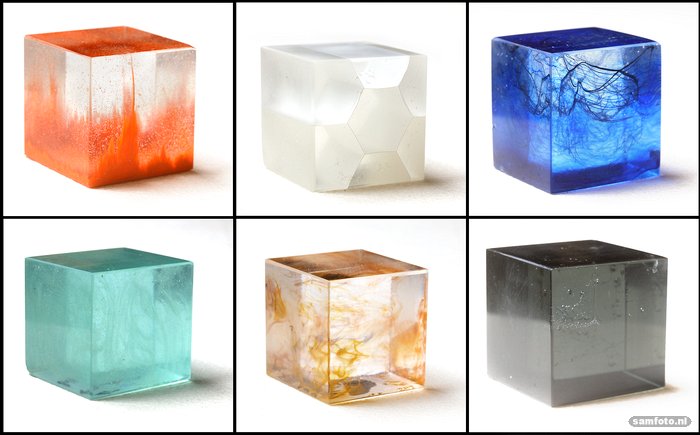Fat glass, the building brick of circularity
The solid glass façade of Chanel’s Crystal House in Amsterdam was their breakthrough. Three years on, Faidra Oikonomopoulou’s and Telesilla Bristogianni’s ‘fat glass’ has colour, curves and circularity.
The glass brick wall of a boutique in Amsterdam’s PC Hooftstraat is a spectacular sight. Its structure mirrors the masonry of the adjacent premises with its trio of high windows set in classic rigid brickwork. But the boutique’s bricks at street level are made of solid glass. MRVDV architects came up with the original design of this ‘Crystal House’ after consulting Professor Rob Nijsse (Faculties of Civil Engineering and Geosciences and Architecture and the Built Environment) and Dr Fred Veer (Faculty of Architecture and the Built Environment) because of their expertise in ‘structural glass’.
10 times more pressure-resistant
Glass is commonly considered as a fragile and unpredictable material. Nijsse has proven in numerous architectural projects that solid glass can be used to build load-bearing structures. Lab tests have shown that the Italian-manufactured glass bricks specially created for this purpose were 10 times more pressure-resistant (200 MPa) than normal bricks.
The proviso was that the bricks had to be extremely flat and glued together with a special UV activated glue.
In Civil Engineering’s Glass Construction group, two Greek PhD candidates, Faidra Oikonomopoulou and Telesilla Bristogianni, performed the load tests on the glass bricks with the help of technician Kees Baardolf. They also spent seven months on the construction site in Amsterdam where they taught builders and masons how to construct the glass brick wall within a tolerance of 2 millimetres over the entire height of 10 metres. Their efforts on the ‘Crystal House’ were rewarded with the Innovation Award from the Society of Façade Engineering in London on 1 December 2016. Under the motto ‘Fat glass is our baby’, the PhD candidates declared their devotion to the transparent yet robust material.
Color and curves
Three years later, the Glass Lab in the Stevin II Hall of the Civil Engineering building has undergone a major extension. Their original workplace, a dark corner under the stairs, has given way to a roomy and light space. In the back, there are two large furnaces the size of walk-in cupboards. Dozens of glass cubes, forming a pallet of colours and patterns, lie on a large table. Next to them are small piles of glass bricks. Some look like Lego blocks, others are shaped like shackles from a chain. The material has changed as well. There’s not only colourless transparent glass but some shapes are semi-transparent with frozen whirls of colour while others are as opaque as marble.
In the hands of Bristogianni and Oikonomopoulou, fat glass has diversified. It now has colour, patterns, shades of transparency, and curves. Despite the great variety of glass products – think of crystal, optical glass, laboratory tubes, car glass or TV tubes - glass from bottles is the only type that is recycled (73.5 % in the EU). Other types of glass are kicked out of the recycling system because of a toxic heavy metal content or because metal specs called intrusions will cause cracks in bottles or window panes. It ends up in landfills, road foundations, or as grains on abrasive paper. Ironically, glass that is routinely trashed often reveals unexpected beauty when melted and cast as small cubes.
The form of the original glass, the size of the grains, the melting temperature and the speed of cooling all influence the outcome of the cast glass. “The higher the temperature, the more homogenous the melt,” says Oikonomopoulou. “This means that higher temperatures create clearer glass.” Bristogianni adds that the speed of cooling influences the crystallisation process. More crystals grow in the material during slow cooling. “Melting glass is like a cook book,” she says. “There are so many variables that will lead to a totally different outcome.”
Cook book
Much of their research has been to build an inventory of the various types of glass and their ability to be reused as cast glass. In a paper* with Prof. Nijsse and Dr Fred Veer, Oikonomopoulou and Bristogianni give a glimpse of their glass cook book. They mention, for example, that TV tubes and crystal tableware with high heavy metal content are nonetheless ‘excellent sources’ for kiln-cast glass with a melting point of between 750-900 degrees Celsius. Window glass and mouth-blown remnants require a higher temperature and quick cooling to become fully transparent. Alternatively, lower temperatures and slower cooling results in a less homogenous and visually more appealing material. The possibilities seem endless.
Looking back to the Crystal House, the researchers in the Glass Lab have developed more naturally shaped building blocks that don’t require chemical glues to stick. “Cooling glass naturally takes on an egg shape,” says Oikonomopoulou. “That’s why we developed curved forms instead of rectangular bricks.” Another innovation is the interlocking form of building blocks. They fit onto each other like Lego – and they can be taken apart anytime to be reused.
Showcase for sustainability
The Glass Lab has developed a process it calls Re3 Glass – upcycling waste glass into a visually attractive and durable building material. The procedure consists of recycling discarded glass, reducing material demand and the embodied energy, and making reusable building material that doesn’t require chemical glues. Reduce, reuse, recycle. That philosophy, applied to waste glass, earned them a nomination for the New Material Award 2018. The jury considered Re3 Glass to be a showcase for sustainability.
Because of the inherent variety in incoming material, Re3 Glass will probably fit special architectural projects better than large scale industrial processes. Oikonomopoulou and Bristogianni envision the production of tailor-made badges of 3D glass elements for façades, floor slabs or interior design objects. “Glass bricks are the building blocks for circularity,” Oikonomopoulou says suddenly. That’s nicely put.



